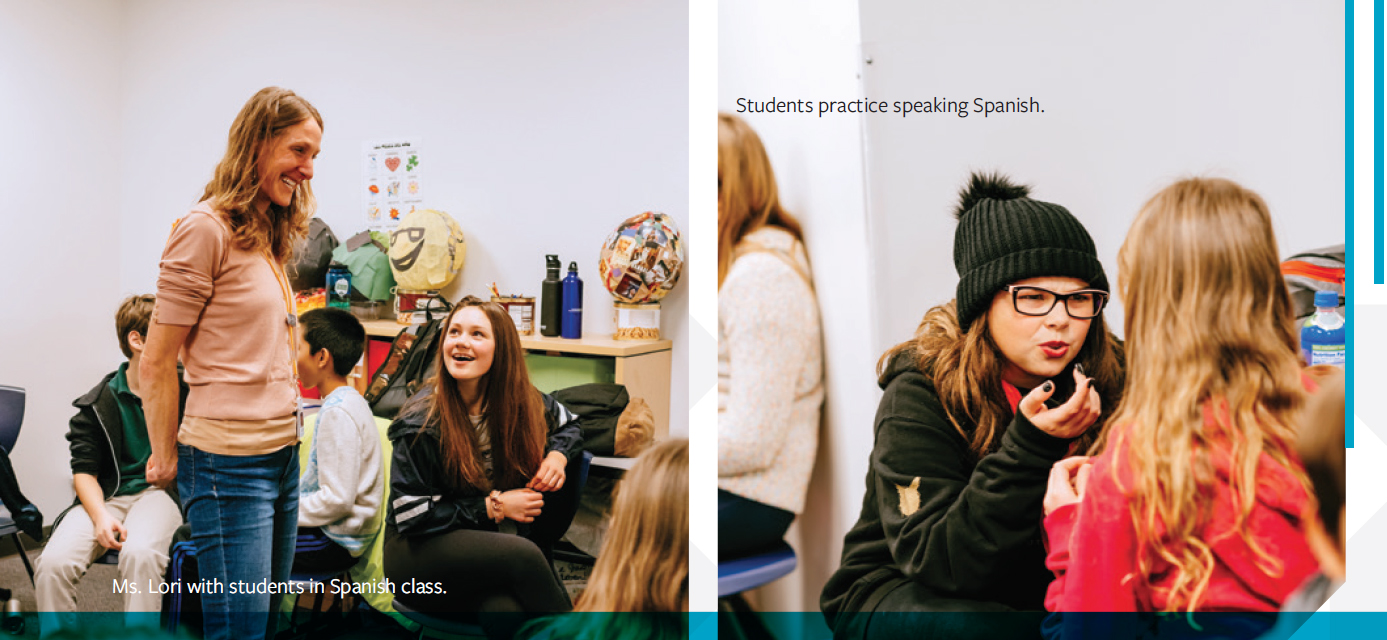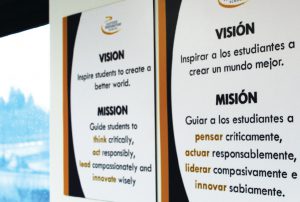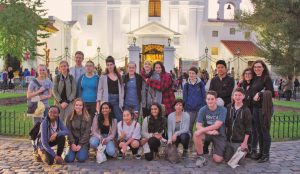
Student: “Puedo ir al baño?” (Can I go to the bathroom?)
Teacher: “Sí, se puede ir sin pedirme. Todo lo que necesitas hacer es escribir tu nombre en la pizarra.”
(Yes, you can go without asking me. All you have to do is write your name on the board.)
The Intention of One World Language at Eastside Prep
By Kelly Violette, Spanish Faculty
EXCHANGES LIKE THE ONE ABOVE TAKE place all day every day in Spanish classes worldwide, so what makes this one special? It’s that this interaction took place in a Mathematical Thinking class. At Eastside Prep, where students can use Spanish to conduct science experiments, customize their breakfast omelets, perform hit music in an assembly, count off for teams in P.E., and ask their math teachers a question, Spanish is more than just a class; it’s woven into the fabric of the school.
Our school founders were intentional in their decision that Spanish would be the only world language taught in our curriculum. They envisioned a school where the language discipline wouldn’t be one among many subjects siloed off from one another, but where the students’ experience of language could enhance and be enhanced by their integrated study of the humanities, the natural sciences, and the arts. According to the vision, Spanish could be part of the daily experience of being on campus and it could extend beyond the walls of the school to educational experiences out in the community and around the world. In order to achieve this vision, it was necessary for there to be one unifying world language shared by the EPS community. And in a country and a continent where Spanish is a dominant language (it’s the second-most-spoken language in the U.S., with over ten times as many speakers as Mandarin, which is in third place), the choice of Spanish was intentional as well.
INTEGRATED CURRICULUM
 In the fifth-grade science lab, there is a poster on the wall that details El método científico (The Scientific Method) in Spanish. Elin Kuffner, EPS science teacher and proud Spanish speaker, works closely with Josefa Ruiz, fifth-grade Spanish teacher, to find creative ways to integrate the students’ experiences in Speaking Spanish and Scientific Thinking. The two teachers coordinate their units so that students learn vocabulary in Spanish that they can use next door in the science lab. Earlier this spring, they studied the reptilian circulatory system and then met with fifth graders from one of our peer schools who had focused their unit on the human circulatory system. Using vocabulary they had spent weeks practicing with their Spanish and science teachers, the fifth-grade students from both schools used Spanish to introduce themselves, play some fun getting-to-know-you games, and then compare and contrast the circulatory systems they had each learned about in their respective science classes. Around the time of this magazine’s publication, our same fifth graders will bring a math teacher out to eat with them at a Latin American restaurant where they will order from the menu, maintain friendly lunch conversation, and calculate taxes and tips (coordinated with their Mathematical Thinking unit on percentages)—all in Spanish. They’ll be coached and supported along the way by more advanced students from the Upper School Spanish 3 class who will accompany them on their lunch outing. Finally, Ruiz and Kuffner will sync up their units on Animales/Animal Behavior so that students learn vocabulary related to animals and their habitats in Spanish class in preparation for a trip to the zoo where they will conduct observations of animals as part of their Scientific Thinking projects.
In the fifth-grade science lab, there is a poster on the wall that details El método científico (The Scientific Method) in Spanish. Elin Kuffner, EPS science teacher and proud Spanish speaker, works closely with Josefa Ruiz, fifth-grade Spanish teacher, to find creative ways to integrate the students’ experiences in Speaking Spanish and Scientific Thinking. The two teachers coordinate their units so that students learn vocabulary in Spanish that they can use next door in the science lab. Earlier this spring, they studied the reptilian circulatory system and then met with fifth graders from one of our peer schools who had focused their unit on the human circulatory system. Using vocabulary they had spent weeks practicing with their Spanish and science teachers, the fifth-grade students from both schools used Spanish to introduce themselves, play some fun getting-to-know-you games, and then compare and contrast the circulatory systems they had each learned about in their respective science classes. Around the time of this magazine’s publication, our same fifth graders will bring a math teacher out to eat with them at a Latin American restaurant where they will order from the menu, maintain friendly lunch conversation, and calculate taxes and tips (coordinated with their Mathematical Thinking unit on percentages)—all in Spanish. They’ll be coached and supported along the way by more advanced students from the Upper School Spanish 3 class who will accompany them on their lunch outing. Finally, Ruiz and Kuffner will sync up their units on Animales/Animal Behavior so that students learn vocabulary related to animals and their habitats in Spanish class in preparation for a trip to the zoo where they will conduct observations of animals as part of their Scientific Thinking projects.
“They envisioned a school where… the student’s experience of language could be enhanced by their integrated study of the humanities, the natural sciences, and the arts.”
When the seeds of Spanish integration are planted in the fifth grade, the roots grow and deepen over the course of a student’s time at EPS. Seventh graders do character analysis in their Spanish classes with Malcolm Yates based on the novels they’re reading across campus in English. Meanwhile, in their Literary Thinking class, Allison Luhrs calls on their knowledge of Spanish grammar to draw comparisons and help them deconstruct the components of English grammar. In eighth-grade science, Burton Barrager shows the students the relationship between planet names and days of the week, drawing on their knowledge of English (representing Germanic languages) and Spanish (representing Romance languages). In Stephen Keedy’s ninth- and tenth-grade Latin American Literature class, students read de-classified CIA documents in both Spanish and English. History students watching movie clips in Sarah Rainwater’s classes often find themselves treated to Spanish subtitles rolling through at the bottom of the screen. And many students, over the years, have participated in field trips to see exhibits featuring Hispanic artists at the Seattle Art Museum. Following such experiences, students work with Spanish, visual arts, and creative writing teachers to produce projects inspired by their day at the museum.
This level of cross-disciplinary integration is a fundamental part of the EPS experience, and it wouldn’t be possible in a school where the student body was split among a handful of world languages. World language teachers have always been able to bring other subjects into their classrooms, but it is only the intentional cultivation of a bilingual community that allows teachers of other disciplines to bring Spanish into theirs.
BILINGUAL SCHOOL CULTURE
As any student will surely attest, the school experience is about much more than what happens inside the classrooms. Because our entire student body is engaged with Spanish in some way, we are able to bring Spanish out into the common spaces, all-school assemblies, and after-school social and cultural activities. This is visible in our hallways, where you can see our TALI mission points outlined in Spanish alongside the English, and it’s audible in the Levinger-Poole Commons every Friday when you hear the stream of laughter and conversation coming from the Mesa de Español (Spanish Table) or when you walk by students asking Javier Fernandez, dining services team member, for a cup of soup or a plate of gluten-free noodles in Spanish. Spanish is sprinkled throughout the school day here, extending well beyond the walls of our classrooms.

Faculty and students visit Argentina during EBC Week.
Students at EPS also enjoy unique opportunities to put their skills on display to a wider bilingual audience. A few times each year, students gain valuable public speaking experience by presenting their project work to the entire student body during an Assembly—in Spanish. The very thought of this probably makes most readers’ stomachs do flip-flops when they think of speaking before an audience in a non-native language, but our students embrace the challenge and our audiences support and encourage them throughout. A highlight from one recent year was when students from the Advanced Spanish Conversation through Music class performed an acoustic rendition of “Bailando” by Enrique Iglesias during Assembly, blending their Spanish skills with various instruments and vocals to perform for a suitably impressed audience.
The Día de los Muertos (Day of the Dead) celebration is one of the highlights of the EPS social calendar each fall. Students enjoy making arts and crafts, listening to music, and tasting delicious Mexican treats like tamales, pan de muertos (“bread of the dead,” a sweet bread traditional for this occasion), and jamaica (hibiscus juice). Upper School art students paint the faces of their Middle School counterparts (and some brave faculty members), creating a spectacle of smiling skeletons in the LPC. Many students also participate in activities related to El Día de los Muertos in their Spanish classes, and they love bringing that cultural learning to life with their friends after school.
A few times each year, students gain valuable public speaking experience by presenting their project work to the entire student body during an Assembly—in Spanish.
EDUCATION BEYOND THE CLASSROOM
Undoubtedly one of the greatest benefits of our single-language approach at EPS is the way it allows us to focus our international Education Beyond the Classroom (EBC) offerings on trips that allow for true linguistic and cultural immersion. Each year we offer students two or more options to experience another culture using their Spanish language skills. Over the past five years, EPS students have traveled to and made friends in Peru, Spain, Argentina, Ecuador, Costa Rica, Nicaragua, Guatemala, Mexico, and Cuba. True to our integrative nature, while some of these experiences have been focused solely on language and cultural immersion, others have been partnerships with faculty from the Fine & Performing Arts and Biology disciplines and the outdoor education program, allowing students the opportunity to use their Spanish language skills to explore an area of interest in an entirely new context. Without fail, students return from these trips wiser, more compassionate, and more aware of what it means to be a global citizen. Many students and recent alums wrote in to share their thoughts about what their Spanish-immersion EBC experiences had meant to them; highlights from their comments can be read in the box to the right of this story.
INTENTIONALITY
Language was never meant to be confined within the walls of a classroom. Language is art, literature, history, science, and math. It’s culture, philosophy, and social change. The words we know provide both the lens through which we understand and categorize our experiences in the world and the tools we have to share our thoughts and feelings with others. Broadening one’s linguistic toolbox is an incredibly reliable way to broaden one’s worldview. But the true potential of language can’t be realized by studying verb conjugations and vocabulary lists inside four walls. At EPS, we are cultivating an intentionally bilingual community where Spanish is part of the daily lived experience. And sometimes, the daily lived experience means asking to go to the bathroom during Mathematical Thinking.
CHRISTY KEARNY, CLASS OF 2017
Participant on EBC trips to Guatemala, Nicaragua, and Costa Rica
The most meaningful experience of these trips is taking a subject I had studied academically and turning it into a practical skill. The first time I experienced this was during my freshman year at EPS, when I went on an EBC trip to Guatemala. There, we participated in a service project with a local youth group. While I was helping to paint bathroom stalls for an elementary school, I started to talk with a boy around my age who lived in the village. While my Spanish was halting, his English was even worse. We ended up conversing about our favorite bands in Spanish, using simple words and lots of hand gestures. Looking back, it’s hard to express all that this moment meant to me. Being able to speak with somebody who, without my academic background, would have been impossible to communicate with opened up an entirely new world to me. After that trip, I began to take my Spanish studies much more seriously as I knew it was the key to unlocking more of the world.
If I didn’t speak Spanish, there would be no comparison to my experience. Being able to speak the language made me a student, rather than a tourist. It made me feel like I was putting in the effort to be there, rather than having people conform to me.
JOLYN HENRY, CLASS OF 2018
Participant on EBC trips to Costa Rica and Argentina
My ability to communicate in Spanish was…integral, I’d say, to my enjoyment of the trips. Part of what was so memorable to me on the trips was my interaction with locals, and that wouldn’t have been possible without my Spanish capabilities. In Costa Rica, my host family didn’t speak a word of English. …Language and culture, sociology, linguistics, are such a fascinating group of topics for me, and the opportunity to interact with local people and talk to them in their language about their culture, while experiencing that culture, is…irreplaceable.
SAOIRSE, CLASS OF 2020
Participant on EBC trips to Costa Rica and Spain
In eighth grade I remember one night during the homestays, the Costa Rica soccer team had a really big game happening, and around ten of us went to one house to watch it. We got to spend time with the family and they were so welcoming and kind. They rearranged their living room so everyone could sit and we ate chips and bean dip while talking to the other people our age about their lives and ours. It is definitely something I will never forget.
If I wasn’t able to communicate in Spanish, it wouldn’t be a cultural immersion experience. I wouldn’t be able to get to know anybody on a personal level and we would probably just be sightseeing—which is amazing, but it is always better when you can speak to people as well.
ADAM BENMALEK, CLASS OF 2017
Participant on EBC trips to Cuba, Nicaragua, and Costa Rica
There are many parts of life that are constantly lost in translation when two individuals do not speak the same language. Being able to converse, fluently and with ease, allowed both the visitors and the hosts to open up and be vulnerable with one another, making this experience most enjoyable for both parties.

